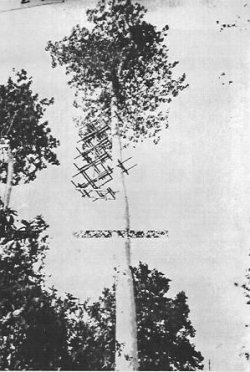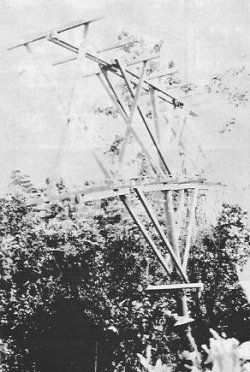![]() The Pacific War Online Encyclopedia
The Pacific War Online Encyclopedia
|
| Previous: Tachi-4 Fire Control Radar | Table of Contents | Next: Tachi-7 Early Warning Radar |
 |
 |
| Wavelength | 441, 416, 394, or 375 cm |
| Pulse Width | 10-70 microsecond |
| Pulse Repetition Frequency
|
500 or 1000 Hz |
| Power | 50 kW |
| Range | 125 miles (200 km) aircraft group |
| Antenna |
Nondirectional box or crossed
dipole transmitter Dipole array receiver |
| Weight |
22,000 lb 10,000 kg |
| Production | 350 sets from 1942-6 |
The Japanese Tachi-6 early warning
radar, also described by some Allied sources as the CHI Mark 229 and
originally designated by the Japanese as Type B Fixed Early Warning
Device (Chotampa Kei-kai-ki Otsu,
Yochi-yo), saw
wide
operational use in the war. It had
remarkable range for its very simple design, consisting of a
nondirectional transmitter strung to a tree and up to four separate
receiving
antennas sheltered in tents and rotated by hand. The Japanese considered
it their most reliable and important early warning radar. Examples were
captured
at Noemfoor and Wewak,
and it became known as the Wewak Radar to the Allies. It had almost no
altitude determination capability and was awkward to install in remote
locations.
References
Grunden (2005)
The Pacific War Online Encyclopedia © 2007, 2009-2010, 2013 by Kent G. Budge. Index